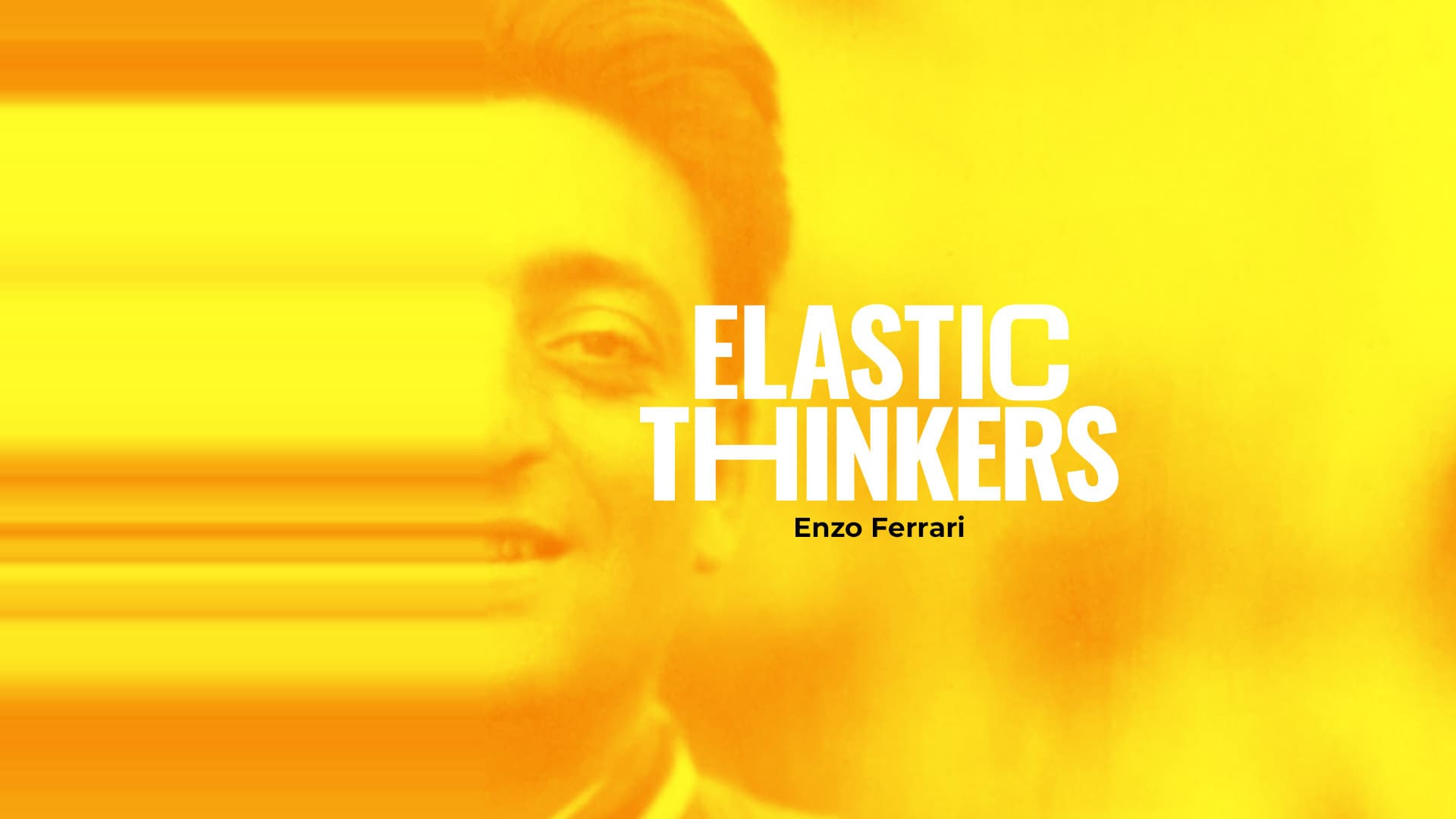It’s hard to believe that the most expensive car ever to be sold at auction cost a staggering $48,450,000. What is probably less of a surprise is that it was a red Ferrari. A 1962 Ferrari 250 GTO, to be exact.
It is the holy grail to car fans globally and arguably one of the most famous production cars ever made. In fact, even to those who vehemently believe that “spending money on cars is a total waste of money”, its beauty and elegance are simply undeniable.
Both above and beneath the bonnet, it represents hundreds (probably thousands) of hours of blood, sweat, and craftsmanship. But beauty alone isn’t what makes this car so expensive. It’s what it represents. And that is the unwavering passion of the man we are here to talk about. Enzo Ferrari.
Adored by his compatriots and the motorsport community, his life has much in common with the many other Elastic Thinkers. Filled with challenges, failures, and sadness, his drive, determination, and vision embody what it means to think elastically. And it is what saw a quiet, unassuming man from humble beginnings turn his lifelong passion into the most famous car brand in the world.
Enzo once famously said that if you asked a child to draw a car, he would draw it red. As a young adult, who grew up watching Formula 1, I would struggle to disagree.
“If You Can Dream It, You Can Do It.”
Born in 1898, Enzo Ferrari grew up in Modena, a small city located 40km North of Bolognia. It’s a region synonymous with creativity, with Ferrari growing up in the shadow of master craftsmanship, artistry, music, and architecture.
Distinctive pieces of art in their own right, it is no surprise that Modena fell in love with cars. Nicknamed the ‘Supercar Capital of the World’, don’t let its peaceful and idyllic surroundings fool you. To this day, it remains the home of brands including Lamborghini, Pagani, and Maserati.
It is no surprise, therefore, that like many others his age, a young Ferrari would soon begin dreaming of becoming a race car driver. Where this passion originated for Enzo specifically is debated. However, many agree that a trip to the Circuit of Bologna in 1908 with his father and brother was the true catalyst.
That day, the victory of a driver named Felice Nazarro proved to be all the inspiration a young Enzo needed to pursue what would become a lifelong career in the sport.
“Everyone Dreams of Driving a Ferrari, It Was My Intent from the Start.”
Over the next few decades of his life, Ferrari would confront war, illness, and family tragedy before his motorsport career would properly get going with Alfa Romeo in 1920. Nevertheless, it was a partnership that would last for nearly two decades in various forms. And one that would see Enzo both driving and subsequently overseeing the brand’s racing exploits. A difficult divorce when it came, the process would ultimately trigger the founding of the company known today as Ferrari.
However, Enzo’s solo approach to racing was different from the modern car manufacturers that exist in motorsport today. For many of these brands, building competitive, high-performance race cars is, above all, a marketing exercise. Success is a measurement of not only race victories but by the generation of sales away from the race track.
By all accounts, Enzo’s brand has found its success by doing the exact opposite. Always putting his passion first, he would sell his race cars to well off individuals known at the time as ‘gentlemen racers’. In fact, it wasn’t even until the 1950s that Enzo Ferrari would begin selling cars in a more traditional sense. Opening their first dealership in New York, the brand’s cars of the future were designed to be both race and road-ready.
Ironically, it was this thinking that put racing ahead of profits that would give his brand such immense value both on and off the track. So much so that Ferrari is the only manufacturer who actually receives money, simply turning up to the F1 World Championship.
“The Client is Not Always Right.”
Prioritising the brand’s motorsport exploits is what came naturally to Ferrari. After all, continuing success on the track meant that demand for his cars off it would only rise. He made a commitment to his vision for the brand, and with victory came the freedom to be himself. Even if his approach did contradict many of the modern marketing philosophies.
In fact, many of his personality traits would indeed create countless negative associations for a modern brand. No less for one dealing with wealthy and often famous clientele. However, there was also immense value in his uncompromising, stubborn, and straight-talking approach. For without it, Ferrari would have undoubtedly lost the ethos that has made it such an allure to both competitors and consumers.
Taking even a brief look into Ferrarr’s current practices demonstrates the lasting impact of this thinking. Never choosing to cash in on demand for his cars, Enzo knew that rarity was key to price. Therefore Ferrari has never attempted to build cars in a fashion that would keep pace with demand. Protecting the quality and craftsmanship at the heart of every vehicle, incredibly 2019 was the first time Ferrari has sold over 10,000 models. To put that in perspective, last year, BMW sold 2,213,795 cars.
Enzo also wasn’t just interested in whether you had the money to buy a Ferrari. And at a time, he resented the idea that they would become anything more than a status simple. As a result, there remain multiple conditions that come with both buying and then owning a Ferrari. These include, but are not limited to: not being able to sell your car in the first year of ownership or being able to make any modifications after purchase.
Above all, he believed that you should challenge your critics and defend your work, once stating, “If you like this car, we’ll make it. If you don’t, we won’t.” Famously stubborn in the face of criticism from consumers, one such interaction famously spurned the creation of Lamborgini supercars. You can read more about that story here.
“I am a Man Who has Lived an Adventure.”
For a man who lived out his dreams at the forefront of motorsport, Enzo Ferrari was a notoriously private person. Famously splitting his time moving between his home the Ferrari factory in Maranello, even after he stepped away from Ferrari’s day to day running, his presence loomed large.
Since his death in 1988, the Ferrari brand has continued to grow, developing cars that abide by many of his core principles. However, it would be amiss not to acknowledge how much it has changed. Expanding its footprint into everything from high-end fashion to theme parks and merchandise. It’s a brand whose global reach now expands far beyond the bounds of motorsport and cars.
As a result, it does make you wonder what the man behind the glasses would have thought. Would he be proud of its achievements both on and off the track? Or be dismayed by a brand now unrecognisable from the one he founded all those years ago? I guess we will never know.



